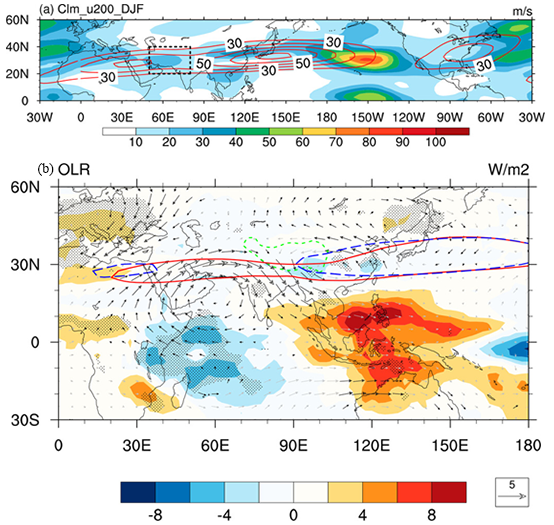The winter Middle East jet stream (MEJS), which is an upper-level westerly jet located over the northern Arabian Peninsula, is an important upstream signal for the East Asian winter monsoon and the subsequent Asian summer monsoon. However, the studies on the variations of the MEJS and their climate impacts are limited compared to the East Asian jet stream and the North American jet stream.
The Innovation Team for Ocean-Land-Atmosphere Interaction and Global Effect of the Southern Marine Science and Engineering Guangdong Laboratory (Zhuhai) systematically investigated the dynamical mechanisms for the maintenance and interannual variations of the MEJS and its influences on the Asian winter and summer monsoons. It was found that the MEJS was mainly maintained by the tropical diabatic heating and the low-frequency transient eddy (TE) vorticity forcing, different from the East Asian jet stream which was maintained by both tropical diabatic heating and high-frequency TE vorticity forcing and the North American jet stream which was mainly sustained by high-frequency TE vorticity forcing (see Table 1). On interannual time scales, the meridional shift of the MEJS is related to low-frequency TE heating, while the variation of the jet’s intensity is associated with temperature advection. Furthermore, the diabatic heating over the western tropical Indian Ocean exerts a significant influence on the MEJS (Fig. 1), whose eastward extension leads to a wetter and colder winter in southern China and a later onset of the Asian summer monsoon. The anomalous signals from mid-to-higher latitudes and the eastern tropical Pacific may be involved in the variation of convection over the western tropical Indian Ocean, which exerts a more significant effect on the Asian monsoon through the MEJS. The winter MEJS variability can be considered an important indicator for the Asian monsoon.
The results obtained were published in two articles in The Journal of Climate in June 2022, entitled “Zonal extension of the Middle East jet stream and its influence on the Asian monsoon” and “Dynamical analysis of the Middle East jet in winter: Compared to the East Asian jet and the North American jet”. Professor Song Yang, Principle Investigator of the innovation team, is the corresponding author of these articles. Team member Dr. Wei Wei, Associate Professor of the School of Atmospheric Sciences, Sun Yat-sen University, and PH.D. student Miss Qiaoling Ren from the School of Atmospheric Sciences, Sun Yat-sen University, are respectively the first authors of two articles. These studies were partially supported by the research grants from the National Natural Science Foundation of China, the Innovation Group Project of Southern Marine Science and Engineering Guangdong Laboratory (Zhuhai), and the Guangdong Province Key Laboratory for Climate Change and Natural Disaster Studies.
Table 1 List of the main characteristics of the jet streams discussed. The second row shows the dynamic types of the jets, while the third row lists the primary dynamical processes contributing to the maintenances of the climatological jets. The last two rows list the dynamical processes that positively contribute to the interannual variations of the jets.

Figure 1. (a) Climatological westerly jet streams (red contours from outside to inside indicate the zonal winds of 30, 40, 50, 60, and 70 m s−1, respectively) and the interannual variance of zonal wind (shaded; m2 s−1) at 200 hPa during DJF from 1979 to 2020. Black box indicates the region 20°–40°N/50°–80°E for the MEJS index. (b) Regressed horizontal wind anomalies (vectors; m s−1) at 200 hPa and OLR anomalies (shaded; W m−1) in DJF against the index of OLR (multiplied by -1) over the WTIO (20°S–5°N/40°–60°E). Contours indicate the composite zonal winds at 200 hPa for the minus OLR index higher than 1 (50 m s−1; red solid contours) and lower than −1 (50 m s−1; blue dashed contours). Dots and dark vectors indicate the partial correlation coefficients in these areas exceeding the 0.05 significance level. Contours in green indicate the Tibetan Plateau region for elevations exceeding 3000 m.


